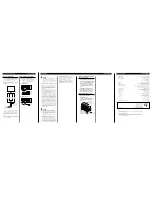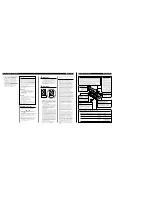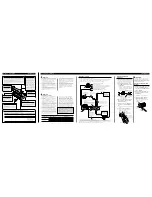
Connection Diagram
• This diagram shows connections using external output (subwoofer output). Slide the input switch to the left.
• When you connect with speaker output, connections defers from the diagram. For details, see the “Using the
Speaker Input” section. In either case, you need to set the input switch. For details, see the “Setting the Unit”
section.
CAUTION:
To prevent damage and/or injury
• Do not ground the speaker wire directly or con-
nect a negative (–) lead wire for several speakers.
• This unit is for vehicles with a 12-volt battery and
negative grounding. Before installing it in a recre-
ational vehicle, truck or bus, check the battery
voltage.
• If the car stereo is kept on for a long time while
the engine is at rest or idling, the battery may go
dead. Turn the car stereo off when the engine is at
rest or idling.
• If the system remote control wire of the amplifier
is connected to the power terminal through the
ignition switch (12 V DC), the amplifier will
always be on when the ignition is on— regardless
of whether the car stereo is on or off. Because of
this, the battery could go dead if the engine is at
rest or idling.
• Speakers to be connected to the amplifier should
conform with the standards listed below. If they
do not conform, they may catch fire, emit smoke
or become damaged. The speaker impedance must
be 2 to 8 ohms for stereo connection, and 4 to 8
ohms for monaural and other bridge connection.
• Install and route the separately sold battery wire
as far away as possible from the speaker wires.
Install and route the separately sold battery wire,
ground wire, speaker wires and the amplifier as
far away as possible from the antenna, antenna
cable and tuner.
• Cords for this product and those for other prod-
ucts may be different colors even if they have the
same function. When connecting this product to
another product, refer to the supplied Installation
manuals of both products and connect cords that
have the same function.
Connecting the Unit
<ENGLISH>
CAUTION
• Disconnect the negative (–) terminal of the battery
to avoid the risk of short-circuit and damage to
the unit.
• Secure the wiring with cable clamps or adhesive
tape. To protect the wiring, wrap adhesive tape
around it where they lie against metal parts.
• Do not route wires where they will get hot, for
example where the heater will blow over them. If
the insulation heats up, it may become damaged,
resulting in a short-circuit through the vehicle
body.
• Make sure that wires will not interfere with mov-
ing parts of the vehicle, such as the gearshift,
handbrake or seat sliding mechanism.
• Do not shorten any wires. Otherwise the protec-
tion circuit may fail to work when it should.
• Never feed power to other equipment by cutting
the insulation of the power supply wire to tap
from the wire. The current capacity of the wire
will be exceeded, causing overheating.
• Never replace the fuse with one of greater value
or rating than the original fuse. Use of an improp-
er fuse could result in overheating and smoke and
could cause damage to the product and injury
including burns.
Speaker Channel
Speaker Type
Power
Two-channel
Subwoofer
Nominal input: Min. 150 W
Other than subwoofer
Max. input: Min. 300 W
One-channel
Subwoofer
Nominal input: Min. 600 W
Other than subwoofer
Max. input: Min. 1 200 W
Setting the Unit
<ENGLISH>
Gain Control
If the sound level is too low, even when the volume of the car stereo used along
with this power amplifier is turned up, turn gain control clockwise. If the sound
distorts when the volume is turned up, turn the gain control counter-clockwise.
• When using with an RCA equipped car stereo (standard output of 500 mV), set to
the NORMAL position. When using with an RCA equipped Pioneer car stereo
with max. output of 4 V or more, adjust level to match the car stereo output level.
• If you hear too much noise when using the speaker input terminals, turn the
gain control counter-clockwise.
Power Indicator
The power indicator
lights when the power is
switched on.
Connecting the Power Terminal
• Always use the special red battery and ground
wire [RD-223], which is sold separately. Connect
the battery wire directly to the car battery positive
terminal (+) and the ground wire to the car body.
1. Pass the battery wire from the
engine compartment to the interior
of the vehicle.
• After making all other connections to the
amplifier, connect the battery wire terminal of
the amplifier to the positive (+) terminal of
the battery.
2. Twist the battery wire, ground wire
and system remote control wire.
3. Attach lugs to wire ends. Lugs not
supplied.
• Use pliers, etc., to crimp lugs to wires.
4. Connect the wires to the terminal.
• Fix the wires securely with the terminal
screws.
WARNING
Failure to securely fasten the battery wire to the ter-
minal using the terminal screws could cause the ter-
minal area to overheat and could result in damage
and injury including minor burns.
Connecting the Speaker Output
Terminals
1. Expose the end of the speaker wires
using nippers or a cutter by about
10 mm (3/8 inch) and twist.
2. Attach lugs to speaker wire ends.
Lugs not supplied.
• Use pliers, etc., to crimp lugs to wires.
3. Connect the speaker wires to the
speaker output terminals.
• Fix the speaker wires securely with the termi-
nal screws.
Fuse (30 A)
Engine
compart-
ment
Interior of
the vehicle
Drill a 14 mm
(1/2 inch) hole
into the vehicle
body.
Insert the O-ring rubber
grommet into the vehicle
body.
Positive terminal
GND terminal
Power terminal
Battery wire
System remote
control terminal
System remote
control wire
Ground wire
Speaker
output
terminal
Terminal screw
Fuse (30 A)
Speaker wire
BFC (Beat Frequency Control)
Switch
BFC switch is on the bottom of the
unit. If you hear a beat while listen-
ing to an AM broadcast with your car
stereo, change the BFC switch using
a small standard tip screwdriver.
LPF (Low-Pass Filter)/HPF (High-Pass Filter) Select Switch
Set the LPF/HPF select switch as follows according to the type of speaker that is connected to the
speaker output connector and the car stereo system:
LPF/HPF Select
Audio frequency range
Speaker
Remarks
Switch
to be output
Type
LPF (Left)
* — 40 Hz to 120 Hz
Subwoofer
Connect a subwoofer.
OFF (Center)
Full range
Full range
HPF (Right)
* 40 Hz to 120 Hz —
Full range
Use if you want to cut the very low
frequency range* because it is not
necessary for the speakers you are using.
* See the “Cut Off Frequency Control” section.
Terminal Cover
Before setting up the unit,
unfasten the screws with a 4
mm or 5/32 inch hexagonal
wrench (not supplied) and
remove the terminal cover.
Cut Off Frequency
Control
If the LPF/HPF select
switch is set to LPF or
HPF, you can select a cut
off frequency from 40 Hz
to 120 Hz.
Bass Boost Control
You can select a bass boost level from 0, 6, 9 and 12 dB.
For instruction of connecting the bass boost remote control
to the amplifier, see the “Connection Diagram” section.
Input Switch
It is possible to input from a car
stereo external output (subwoofer
output) or a car stereo speaker
output. When using an external
output (subwoofer output), slide
the switch to the left. For connec-
tion instructions, see the
“Connection Diagram” section.
When using a speaker output,
slide the switch to the right. In this
case, it is necessary to use the
supplied speaker input wire with
RCA pin cord. For details, see the
“Using the Speaker Input” section.
Fuse (30 A)
Grommet
Special red battery wire [RD-223] (sold separately)
After making all other connections at the amplifier,
connect the battery wire terminal of the amplifier to
the positive (+) terminal of the battery.
Ground wire (black) [RD-223] (sold separately)
Connect to metal body or chassis.
Fuse (30 A)
Car stereo with
RCA output jacks
External Output
Connecting wire with RCA
pin plugs (sold separately).
RCA input jack
System remote control wire (sold separately)
Connect the male terminal of this wire to the system remote control terminal of the car stereo
(SYSTEM REMOTE CONTROL). The female terminal can be connected to the auto-antenna
relay control terminal. If the car stereo does not have a system remote control terminal,
connect the male terminal to the power terminal through the ignition switch.
Speaker output terminal
See the “Connecting
the Speaker Wires”
section for speaker
connection instructions.
Fuse (30 A)
Bass Boost Remote
Control Wire
Bass Boost
Remote Control
6 m (19 feet 8 inch)
Jack for the bass boost remote control
Connect this jack and the bass boost
remote control with the bass boost
remote control wire.
RCA output jack
Amplifier with
RCA input jacks
RCA input


























